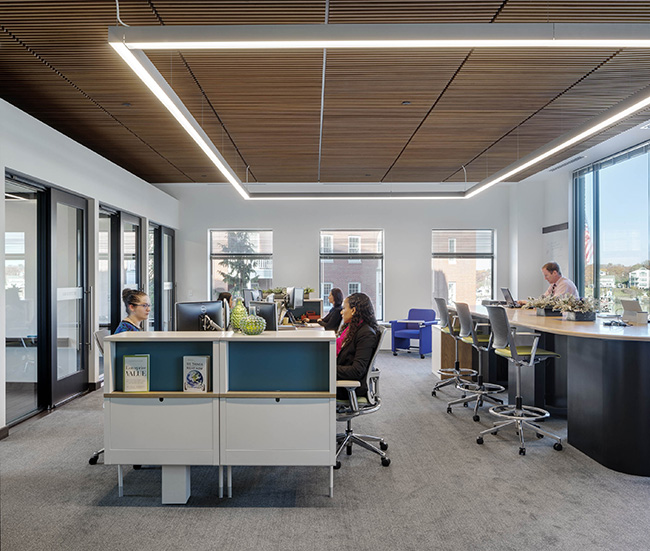It’s Good to Share: the Rise of the Non-Territorial Workplace
I sit at a desk in an open studio, near a window that overlooks Perkins Pier and Lake Champlain. My workspace contains my personal collection of reference books, my bin of college art supplies that I’ve held on to over the years, and photos of my daughters jumping into piles of leaves. I start every day at this desk, in a space that feels just as personal to me as my home.
This is true for the majority of people who toil away in an office, whether it’s in a private room or an open plan. But one emerging trend in workplace design is the non-territorial office, where every space is shared and no one has a desk of their own.
The non-territorial workplace can be traced to what we call Activity-Based Planning. The now-ubiquitous cubicle was once proclaimed to be the ultimate workplace solution: a multi-purpose space for both individual and collaborative work. But we now recognize that while the cubicle provides a mediocre environment for many tasks, it does not provide an ideal environment for any of them.
A better approach to support the variety of tasks throughout the day is to provide a mix of shared spaces that are each designed for different uses. These may range in size, degree of visual and acoustic privacy, and furniture layout. These spaces have typically been offered as a complement to the dedicated office or cubicle, not as a replacement. Workers may spend roughly half of their day at their own desk, with the option to go to a shared space for additional privacy or to meet with others.
But one challenge many companies face when trying to provide more shared spaces is the demand for additional real estate. Many have had to cut back on meeting rooms, team rooms, and focus rooms, because there simply wasn’t enough space for everything. The non-territorial plan addresses the need for multiple space types and deals with the constraints on real estate by eliminating all assigned seats.
The impact on a company’s work culture by making such a change can be huge. Each person must consciously seek out the best space to do their work, forcing everyone to be more proactive in planning their day.
This approach has been tried before. In the midst of the dot-com boom in the mid 1990’s, some Silicon Valley firms experimented with a non-territorial plan. When employees arrived for work in the morning, they were assigned a cell phone, a laptop, and a locker, and were free to roam the office. The experiment only lasted 5 years before it was declared a failure. Workers were frequently unable to find an empty seat, and employees hoarded laptops in their lockers because there weren’t enough to go around.
But now, 20 years later, the nature of work has changed so much that this approach is worth another look. As our devices have gotten smaller and more business is conducted wirelessly, mobility in the office is easier than ever. More significantly, the rise of millennials in the workplace has brought a shift in attitude, with a greater interest in autonomy and a desire for a sense of community. A non-territorial workplace supports both of these goals because it provides individual choice while fostering teamwork.

This was recently the case for a business advisory firm in Portsmouth, NH. When we met this client, they were working in a conventional workspace with rows of segregated private offices. Now, the team works in a collaborative, non-territorial office with a mix of shared spaces and no cubicles in sight. All the Directors and Associates surrendered their desks and simply use whichever space is most appropriate for that day’s activities. By eliminating private offices (which often sit empty for most of the day anyway), we were able to provide a wide range of spaces in a relatively small 3,200 square feet. Workspace options include a 14′ group worktable, glass meeting rooms, private focus rooms, and a full-service kitchen with counter seating, cafe tables, and lounge chairs for casual meetings and client visits.
A change like this takes some getting used to, but the initial feedback we’ve received indicates that the concept is catching on. One of our clients explained it to us like this: Previously, they would primarily work individually, and when they needed to collaborate with their colleagues, they would get up from their desk and find another space. Now, the roles are reversed. Their first and foremost method of work is to collaborate as a team, and if individual time is needed, they leave and find a quiet personal space.
This approach to office design isn’t for everyone. The design of a workplace is a function of each company’s unique style and individual needs. But for some organizations looking for an efficient, highly collaborative environment that provides employees with autonomy and promotes a strong company culture, the non-territorial workplace may be worth considering.
This article was published in the Burlington Free Press on Thursday Nov 19, 2015, under the title “A Primer on the Non-Territorial Office“.